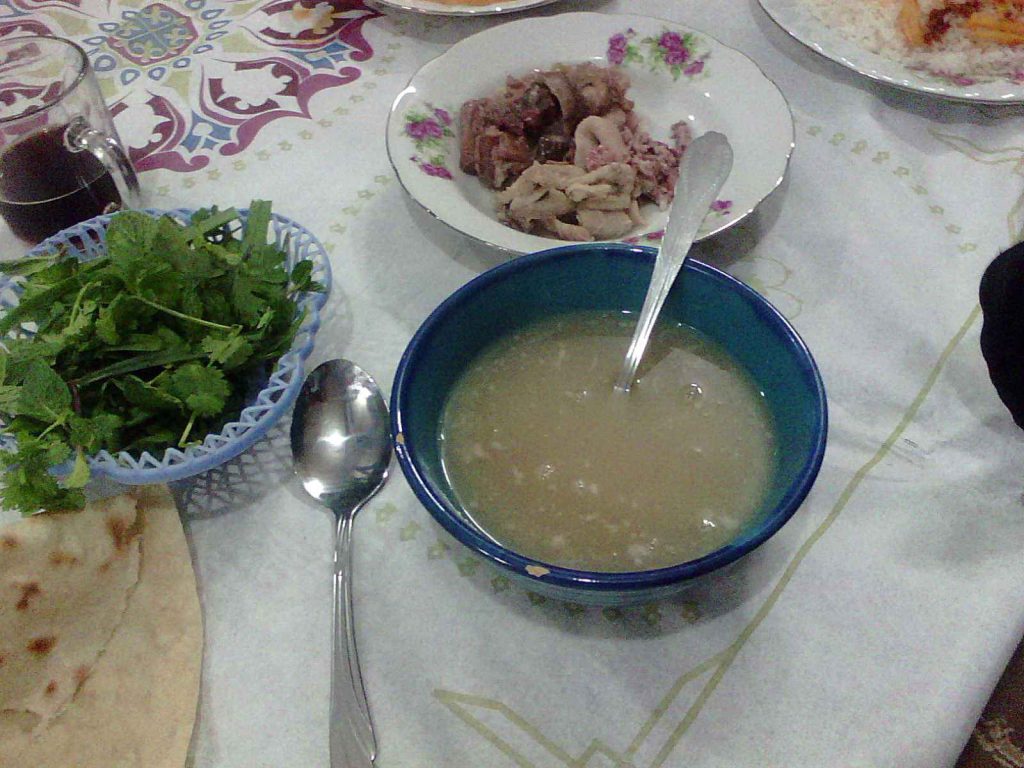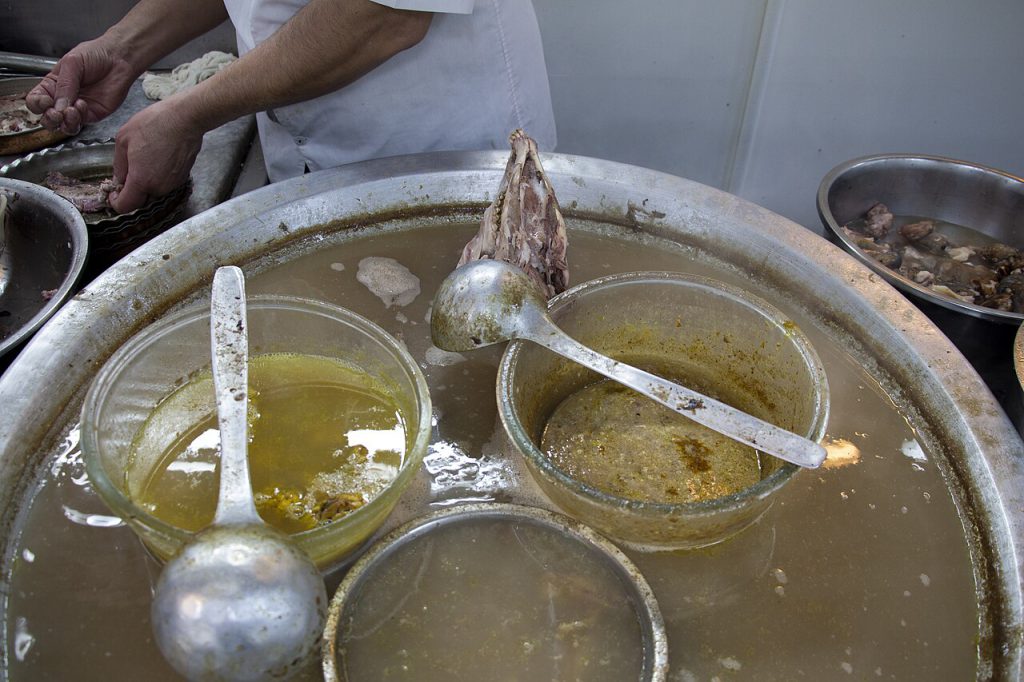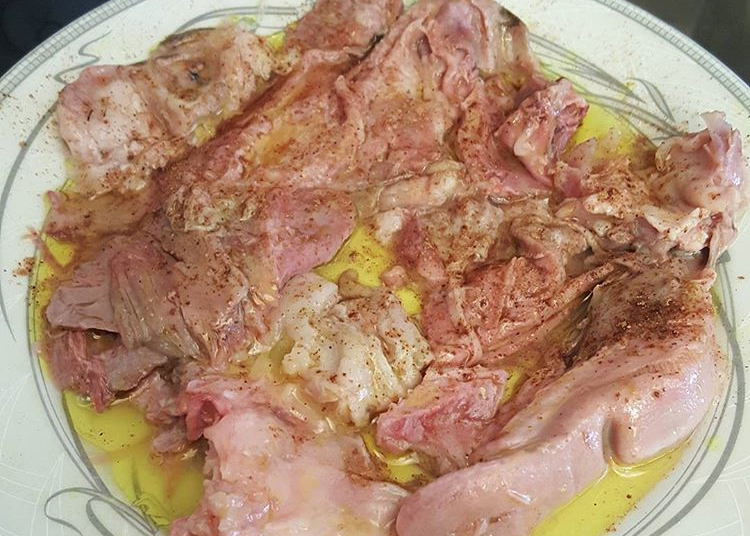Table of Contents
Kale Pache, a customary Persian dish, is a tasty treat that crosses boundaries and combines the flavors of the Middle East and the Caucasus area. This exceptional delicacy, known by various names across different cultures, showcases the rich culinary heritage of these regions.
Prepared with utmost care and patience, Kale Pache is a labor of affection that necessitates slow cooking over gentle heat. The primary ingredient is the sheep’s head, accompanied by an assortment of other parts, including the tongue, brain, meat from the ear region (Banā Goosh in Farsi), eyes, face, and trotters (legs). This combination of ingredients generates a harmonious blend of flavors and textures that is truly extraordinary.
The preparation of Kale Pache is a meticulous process that demands time and perseverance. The sheep’s head and other components are meticulously cleaned and simmered with aromatic onions, peas, and a carefully balanced mixture of spices, such as salt, turmeric, and pepper. This slow-cooking method permits the flavors to mingle together, creating a rich and deeply satisfying broth.
As the dish gently simmers, the aroma of spices and slow-cooked meat fills the air, tantalizing the senses and whetting the appetite. The outcome is a hearty and comforting dish that is frequently served with traditional flatbreads like sangak, pickled garlic (sir torshi), and fresh lemon wedges, allowing diners to customize their experience with each bite.
Kale Pache History

Kale Pache, also known as Kaleh Pacheh or Khash, is a delicious traditional Persian dish that has been enjoyed for centuries. According to recent archaeological findings, the origins of this savory soup can be traced back to around 3,500 years ago in Iran. The dish has since spread throughout the region, becoming a beloved staple in many countries.
In Iran and Turkey, the dish is called Kale Pache, while in Arabic countries, it is known as Pacheh. In Armenia, Azerbaijan, and Georgia, the dish is referred to as Khash. Despite the variations in name, the core ingredients remain the same: sheep or cow’s head, feet, and various other parts, such as the tongue, brain, and eyes.
This dish has a rich history deeply rooted in Iranian history and culture. It is believed to have originated from the nomadic tribes of Iran, where every part of the animal was utilized to ensure nothing went to waste. The dish was initially prepared as a hearty meal to provide sustenance and energy to the nomads during their travels.
Over time, the dish became a beloved breakfast dish in Iran, especially during the colder months. It is considered a nourishing and warming meal, perfect for starting the day. The dish is prepared by simmering the sheep or cow’s head and feet in a flavorful broth with various herbs and spices. The resulting broth is rich and gelatinous, and the meat is tender and flavorful.
This food is not only enjoyed in Iran but also in other countries, such as Albania, Armenia, Bulgaria, Mongolia, and throughout the Middle East. Each region has its own unique variations and traditions surrounding the dish, making it a truly global culinary experience.
Kale Pache: Persian Breakfast
Kale Pache, a traditional meal dating back over 2,000 years, is a flavorful Persian breakfast soup made from a sheep’s head and feet. This calorie-rich food provides a strong energy boost to start the day. Sellers in Iran begin selling hot bowls of Kale Pache before sunrise.
The cooking process is quite lengthy, with cooks spending most of the night cleaning the sheep parts and boiling them for 8 hours to achieve the rich, fragrant flavors.
Kale Pache Ingredients
- 1 sheep’s head and 4 trotters
- 5 onions
- 5 cloves of garlic
- 1 teaspoon turmeric
- 1 teaspoon black pepper powder
- 2 leaves bay laurel
- Dried onion powder (as much as needed)
- Water (as much as needed)
Kale Pache Recipe
1. To clean the head and legs of a sheep, hold each part close to a gas burner flame to burn off any remaining hair and fuzz. Put all the parts in a large pot and wash them for at least 15 minutes. The first time you fill the pot with water, it will become dark and dirty from the dirt on the parts. Keep washing until the water no longer gets dirty when you add the parts. Make sure to wash inside the nose and ears. Some people even brush the sheep’s teeth. You can start cooking the sheep once the washing is complete.
The key points are:
- Use a gas burner to singe off hair and fuzz from the sheep parts
- Wash the parts in a pot of water for at least 15 minutes, changing the water if it gets too dirty
- Wash inside the nose and ears
- Optionally brush the teeth
- Begin cooking once the washing is finished
2. To begin cooking, cut the sheep’s head in half. Chop the onions into two pieces each. Put the halved head, legs, chopped onions, garlic cloves, bay leaves, black pepper, turmeric, and dried onion powder all together in the pot.
The key steps are:
- Cut the sheep’s head in half
- Chop the onions in half
- Add the halved head, legs, onions, garlic, bay leaves, pepper, turmeric, and dried onion powder to the pot
3. Fill the pot with water, making sure the water level is well above the ingredients. Put the pot on a high heat gas burner flame until the water starts boiling. Once boiling, turn the burner down to a lower flame and let the pot simmer for at least 5 hours. In the last 30 minutes of cooking, add some salt.
The key steps are:
- Fill the pot with water, covering the ingredients
- Bring to a boil on high heat
- Reduce to a simmer on low heat for 5+ hours
- Add salt in the final 30 minutes
How to Seve Kale Pache
- 1. Remove the feet, tongues, and heads from the pot after cooking.
- 2. Carefully take out the meat, tongue, brain, and eyes from the skulls. Keep the eyes aside as they are considered the best part – a reward for your efforts!
- 3. To prepare the tongues for serving, hold them under cool running water. The skin should slip off easily.
- 4. Arrange all the meat, including the skinned tongues, on a serving platter.
- 5. The flavorful broth is typically served separately.
- 6. Provide flatbread, such as noon sangak, sir torshi (pickled garlic), other torshi (pickles), cinnamon powder, and lemon juice on the side.
- 7. Encourage your guests to soak pieces of the bread in the rich broth, allowing them to savor the combination of textures and tastes.
Enjoy your delicious dish! Remember, this dish requires time and effort, but the end result is well worth it.
Kale Pache Restaurant: Tabakhi

Kale Pache Iranian food is often linked to special restaurants called “Kale Pazi” or “Tabbakhi;” it can also be found in many restaurants all over Tehran, where people can enjoy a delicious Persian breakfast. These Kale Paches restaurants, known as “Tabbakhi,” offer an authentic and satisfying Kale Pache experience, letting diners taste the traditional flavors of Iran.
At Tabbakhi restaurant, Kale Pache is the star of the show, with chefs carefully preparing the dish to perfection using time-honored recipes and techniques.
FAQs about Kale Pache
Q1: What is Kale Pache?
A1: It is a savory soup made from a sheep’s head, feet, and other parts like the tongue, brain, and eyes. It is a popular breakfast food in Iran that provides a filling, energy-boosting meal to start the day.
Q2: What is the history of Kale Pache?
A2: Kale Pache has a long history in Persian cuisine, with origins dating back over 3,500 years. It is believed to have started with nomadic tribes who used every part of the sheep to avoid waste. Over time, it became a beloved breakfast dish in Iran, especially during winter months.
Q3: Where can you find Kale Pache in Tehran?
A3: There are many restaurants called “Tabbakhi” that specialize in Kale Pache. One popular place is Tabakhi Bare Sefid, which is open from 3 am to 9 am daily and is known for serving some of the best in Tehran.
Q4: How is Kale Pache usually served?
A4: After cooking, the meat, tongue, brain, and eyes are removed from the skulls. The tongues are peeled and all the meat is arranged on a plate. The flavorful broth is served separately. Flatbread, pickled garlic, other pickles, cinnamon and lemon are provided on the side so you can add them to your taste.
Q5: What does Kale Pache taste like?
A5: Kale Pache has a rich, savory flavor from the slow-cooked sheep parts and aromatic spices. The broth is thick and gelatinous, while the meat is very tender. The combination of textures and flavors creates a hearty, comforting dish.
Last Words: Experience the Best of Kale Pache with a Customized Tour
Kale Pache is a famous traditional dish from Persia (Iran). It is made from various parts of a sheep, including the head, legs, tongue, brain, eyes, and meat from the ears. This dish combines flavors from the Middle East and Caucasus region.
If you love food and want to try the famous Kale Pache dish in Iran, it’s better to go on a customized tour that fits your interests. With a personalized plan, you can fully experience Iran’s rich food culture and discover the best places that match your taste preferences. To Iran Tour is a top company that offers Iran tours and travel packages.
We specialize in creating amazing experiences for travelers who want to explore Iran’s delicious cuisine. Our experts carefully plan each Iran Tours so you can enjoy the best Kale Pache and discover Iran’s diverse food scene.

